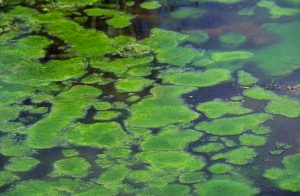Elk Lake

The Elk/Beaver Lake watershed is situated in Saanich District on Vancouver Island, BC, and is conjoined by a channel. The two lakes have different bathymetry and ecological patterns. Elk Lake has a maximum depth of 19 m and an average depth of 7.7 m. Elk Lake stratifies once per year in the summer when the water temperatures are much higher than deepwater temperatures. The minimum winter temperature is around 5˚C and is relatively consistent throughout the water column. Elk lake is subject to winter (Dec-Feb.) cyanobacteria blooms that can be toxic in nature. Fig.2 shows the Bathymetry of Elk/Beaver Lake and Table 2 shows the results from Nordin’s (2015) sampling program to assess the water quality of Elk Lake.
Table. Water Quality Assessment (2015) from Nordin sampling Program
| Parameter | BC WQ | Elk Lake (2014/2015) | Performance comment |
| Temperature | +/-1˚C from ambient | <15˚C below 10m | Set for fish habitat |
| pH | 6.5-9.0 | 7.5 | pH attained |
| Dissolved Oxygen | 8-15mg/L | <5 mg/L 6 months May-Oct | Low DO in summer |
| Spring total phosphorus | 15 μg/L | 33-44 μg/L | Low end of eutrophic scale |
| Chlorophyll-a | — | 6.2 μg/L | Typical range = 2.5 -10μg/L; early January peak of 33μg/L |
| Phytoplankton | — | <50% cyanobacteria | Cyanobacteria typically dominate |
| · BC WQ = British Columbia Water Quality Standard. | |||
W̱SÁNEĆ community’s connection to Vancouver Island Lakes
W̱SÁNEĆ is the indigenous community and is considered to be the people who survived the great flood. Their association with the Saanich Peninsula and the surrounding area goes back thousands of years [8]. W̱SÁNEĆ named the lakes ‘drifts from place to place’, in reference to the island of floating weeds that the W̱SÁNEĆ believed was a monster who brought bad luck to all who looked upon it. Previously they depended on Elk Lake for sustenance but the use of Elk Lake for domestic supply has been stopped since 1977.
Most of the Indigenous communities in Canada are depended on untreated water from the Canadian freshwater bodies for their sustenance and livelihood. Over 99 of these tribes face long-term water insecurities and need a reliable means to assess the water quality to ensure safety and for demanding policy change.
Once fully functional, the Health Monitoring system could be deployed for assessing the water quality for the nearby dependent communities. It is a robust and autonomous system and requires minimal maintenance. The system will provide the much-needed database to device the remediation plan for the HABs issue in Elk Lake. It aims to provide the much-needed low-tech usability and yet feasible system to monitor the water quality in the water bodies.
